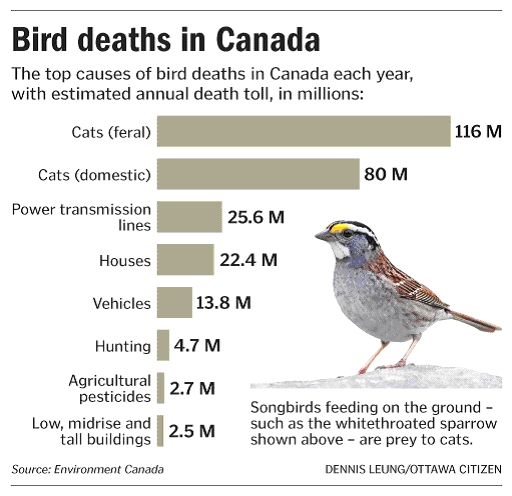|
OUR CATS - Indoors or Out? That’s the Question.Daphne Solecki Big cats such as jaguars, cougars and bobcats are predators. They have to catch, kill and eat other animals in order to survive. Small cats – our pets –also have the instinct to catch and kill prey, but don’t need to. In fact a cat which is munching its kibbles will leave its food to pounce on and kill a mouse or bird, then abandon it to go back to the food in its bowl.Quite often a pet cat will bring in the dead bird or mouse and lay the corpse at the feet of its owner. It does not often eat the prey but the ancient instinct to catch and kill is very strong. In one year a cat may kill 100 birds and small mammals, possibly more. (By the way, putting a bell on your cat doesn’t help. Wild animals don’t know that the sound of a bell means ‘danger’. Also, many cats learn to move carefully so the bell doesn’t ring. )
It is estimated that in Canada there are about 8.5 million pet cats which kill around 80 million birds per year. There are also up to 4 million feral cats (abandoned or lost cats that have gone wild) which kill another 116 million birds. (Environment Canada study, September 2013). On top of all those birds, they kill a huge number of small mammals like mice, voles and moles.
Cats are non-native predators so our native birds and small mammals have not developed defenses to escape them. In addition, when cats catch wild birds and mammals they take food away from native predators which do depend on this small prey to survive. Because it is we humans who own the cats we are responsible for this killing of birds and small mammals. What can we do? 1. Never abandon cats in the wild. People may think that the cats will be adopted by a kind farmer – not so! The cats will go wild (feral). If they avoid starving to death or being eaten by predators then, because they are not neutered, they will mate and raise family after family, all of which have to hunt for food. The whole balance of nature is upset by having so many non-native predators. Just as we get rid of non-native plants which are over-running native flora, so we must reduce the number of non-native animals which are harming our native fauna. 2. Keep cats indoors. This is actually much safer for your pets and they will live longer, according to the SPCA. Outside they can be stolen, get chased by dogs, run over by cars, catch diseases, be poisoned, be exposed to fleas and ticks, get into fights with raccoons and skunks, and - worst of all – get eaten by coyotes. There is nothing a coyote likes better than a nice fat pussy-cat for dinner. Many people who put up "Cat Lost" posters will never see their pet again, though they might find its collar. Making sure your indoor cat is happy. 1. Winter is a good time to get your cat used to staying indoors, because it will probably want to be indoors anyway. A young cat can grow up as an indoor cat and not miss the outdoors at all. 2. Cats need human company to be happy. They are likely to get more attention when they are inside, which will suit them just fine. 3. Provide your cat with:
4. Make sure it has plenty of exercise by rolling those toys around, bouncing them down the stairs, hiding them under the furniture. 5. Trim the cat’s claws every couple of weeks 6. Train your cat to a harness and leash, and take it for walks. 7. Make sure the kitty litter is always fresh and clean. 8. Spritz a kitten with water to teach it to stay away from outside doors. 9. If all else fails, you can let your cat outside providing it is wearing a ‘CatBib’. The cat can run, jump, climb trees, eat, sleep, scratch and groom but it can’t catch birds. (CatBib available at BC Wildlife rescue: www.wildliferescue.ca/merch.shtml)You can get more tips at www.keepanimalssafe.ca www.spca.bc.ca/pet-care and www.abcbirds.org/cats/References: Blancher, P. 2013. Estimated number of birds killed by house cats (Felis catus) in Canada. Avian Conservation and Ecology 8(2): 3. 2013 Environment Canada study – CBC report September 30, 2013 American Bird Conservancy – Cats Indoors Campaign. ******************* End note from John Hunter, 7 ˝ years old, member of Eastern Fraser Valley YNC ""Dogs, cats and coyotes act like they are enemies, so in my opinion we should keep dogs and cats inside at night because coyotes like to come out at night to hunt. This is because a dog or a cat could be badly injured by a coyote. We should also not keep dog or cat food outside because coyotes might eat their food. So, we should feed our dogs and cats inside." |
